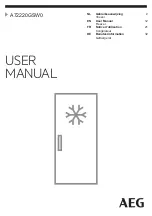
GB-33
GB-32
ENERGY SAVING ADVICE
•
Do not install the appliance close to sources of
heat, such as a cooker, dishwasher or radiator.
•
Locate the appliance in a cool well-ventilated
room and make sure that the air vents are
clear.
•
Try to avoid keeping the doors open for a long
time, as warm air will enter the cabinet and
may cause a build-up of ice as well as a ecting
the energy consumption. Ensure there are no
obstructions preventing the doors from closing
properly.
•
Ensure that the door seals are clean and there
are no tears or splits.
•
Keep the most perishable foods, (those with a
short shelf-life, such as cooked meats), in the
coldest part of the fridge. e Salad Crisper Box
is the warmest part of your fridge and should
be used for vegetables, salads and fruits etc.
•
Do not overload the appliance: the cooling air
that circulates and keeps the appliance cold
gets blocked, and pockets of warm air form.
•
Do not put hot food into the fridge or
freeze
et it cool dow rst.
GB
GB
It is advisable to clean the appliance regularly and to
remove any food deposits or splashes;
in particular, clean the door seals, recesses and
adjacent parts.
Don’t overlook parts of the appliance such as the
humidity controller, light casing, racks,
egg and butter compartments, ice cube tray, and all
of the drainage areas, etc.
If the appliance is not kept clean and in good
condition, its surface could deteriorate and
could lead to a dangerous situation.
Use only a non-abrasive sponge, rinse with clean
water then dry thoroughly before putting
the parts back in place.
Never use abrasive cleaning products or hard
metal scrapers to clean the appliance, as
they could scratch the surfaces and break down
the coating.
After cleaning, leave the inside of the appliance
to dry with the door open before plugging it
into the mains again.
When re-stocking the appliance, be especially
careful not to hit, scratch, crack or break the
internal surfaces.



































